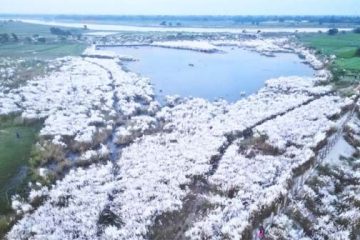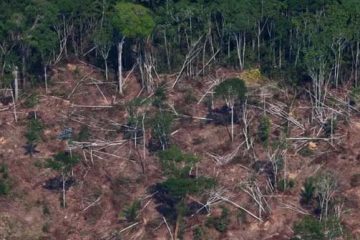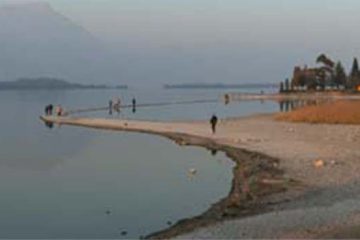Dr. Mohammad Ali
 Tigers are maverick animals. They are supposed to live long in this world. Instead, they are disappearing rapidly. No doubt celebrating ‘tiger day’ will raise awareness to safeguard this majestic animal; however, we hope the affiliated institutions will continue creating a congenial environment for safety and sustainability of tiger population.
Tigers are maverick animals. They are supposed to live long in this world. Instead, they are disappearing rapidly. No doubt celebrating ‘tiger day’ will raise awareness to safeguard this majestic animal; however, we hope the affiliated institutions will continue creating a congenial environment for safety and sustainability of tiger population.
Commonly such safety and protection are provided through declaring protected areas (PAs) like game reserves, wildlife sanctuary, and even national parks. There are overlapping forest reserves and tiger reserves in the Sunderbans as well. The overlapping is because what is for the Sunderbans is for Tiger and what is for Tiger is for the Sunderbans. The Sunderbans and Tigers are inseparable. We wish that the ‘tiger day’ will benefit both Tigers and the Sunderbans.
However, in Bangladesh situation continuing relationship between Forest Departments (FD) in charge of PAs and the local communities living in and around PAs are discouraging. The approach of PA management in Bangladesh is different from western approach. Western PAs constitute creating pristine zones by excluding local communities whereas Bangladesh PAs invite active participation of communities. Of course people do participate in western PAs as well but such participation is spontaneous and influenced by consciousness; whereas, participation in our country is operational and induced by motivation.
Despite illegitimate human killing is considered as the main reason of tiger disappearance. The Balinese tiger was extinct long ago in 1930s due to hunting. Caspian and Java tiger are also extinct due to human pressure. The extinction of Java tiger is very recent only in 1970s. In that regard the effort for tiger conservation is not very old. Presently there are only six sub-species of tiger remaining in the world. All of them are endangered. The total number of individuals of all tiger species around the world is estimated to be alarmingly low, only 3200. Tigers are visible in only 7% areas of their natural home range. Among them the abundance of the Bengal Tiger is highest close to 1100 in India and Bangladesh. In the Bangladesh part Tigers are available in the Sunderbans only and their number is less than 500.
Although higher in number, the Bengal tiger is more prone to extinction because they have the highest interaction with human beings. Ecologically they occupy only one habitat, the Sunderbans. They often hunt on livestock and kill people. Many people die in the Sunderbans due to tiger attack. All of them increase the probability of their extinction. They are more vulnerable because they are surrounded by about eight million people living around the Sunderbans and troubled by three million people entering in the Sunderbans every year. There is no doubt that if these people do not cooperate there is no possibility that tigers in the Sunderbans could be saved.
Albeit, how we arrange participation does matter, the motivational part is very subjective. This is largely because the tools we use for motivation are mainly monetary incentives and NGO perceptive. NGOs in general are very active and successful in their missions; however, in practice they are multilevel profit seeking liaison between the government, people and international agencies. If there is no money, there will be no motivation, thereby, no participation can be expected. Moreover, the responsibility and liability of NGOs are minimal. At least the Wildlife Act does not have such provision. Therefore, the long term conservation of tiger may be affected seriously. Though harsh to generalize, we can say motivations are tool-dependent; thereby, motivational participation needs some additional planning for long term solution.
In our country situation of long term perspective is even bleak, because, NGO involvement is essential tool for any kind of participation. On the other hand, the traditionalism that the forestry people carry from their British ancestors till now generates mistrust. We do not know how many ages they will take to achieve the trust of people. Neither have we known whether tigers will live that long. The least we can say, to save tigers professional people have to be trustable to the general people the sooner the better otherwise many things will be relocated somewhere else including their professionalism. Vis a vis we request the nation to imagine, if any other professional group (e g., Justice) loses the trust of people, as we see with forestry groups, what would be the setback before the nation could rebuild it again?
Otherwise, the operational participation of people is good. The hardworking people of our country are very much dedicated; however, seldom look at professionalism. Once motivated, our politicians do not necessitate allowing officers and professionals working in their respective areas. As a result, trained professionals cannot exhibit professionalism and eventually lose the attribute. On the other hand, people develop a peculiar skill for making their boss happy (traditionally called oiling) but not professionalism. Therefore, appropriate skills are replaced by ‘oiling’ and the professionalism gets relocated from professionals to consultants. If the consultants are from overseas, then the professionalism finds its way seven seas away from the host country.
For tiger conservation FD is much dependent on local people. However, they cannot approach local people directly. NGOs are essential intermediary. It is a pity that people do not trust them directly. Neither the politicians do. Not to blame almost everywhere the forestry professionals have been portrayed not more than burglar of public resources. I do not know how these professionals will work under the teeth of saw. Some people have reservation even to recognize them as professionals; particularly, when they have repeatedly failed to cater a policy for recruiting trained professionals. They do not see how other professionals like engineers, doctors, and agriculturists practice their recruitment. If they think that they can train people professionally after recruitment when they are supposed to practice, they are in wrong mode. It is political rather than professional. They will be losing productive times (Youthful) and public resources for training rather than producing. We hope that our tigers will be saved professionally rather than politically.
(Article originally published on The Daily Star)
The writer is faculty member Department of Environmental Science and Management, North South University.





